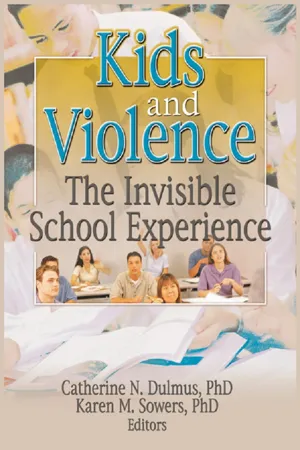
- 216 pages
- English
- ePUB (mobile friendly)
- Available on iOS & Android
About This Book
Implement prevention interventions and policies to curb the cycle of violence in our schools!Kids and Violence: The Invisible School Experience examines overt and covert violence occurring in the school setting involving students, school personnel, and school policy, and highlights a level of violence that is often hidden, ignored, or subtly tolerated. This book provides the latest research findings on various issues of violence in our schools. It also shows what happens when the adults responsible for the well-being of our children are actually perpetrating violence, staying silent about violence, or upholding a system that supports a violent atmosphere.Kids and Violence is unique in its holistic and systemic approach of examining types of violence that are often overlooked or endorsed by school policies. The book includes 11 chapters focusing on issues such as bullying, school personnel's role in violence, and prevention programs. The contributors are experts in their fields and include professors, deans, and directors of university social work schools. Kids and Violence presents the results of an exploratory study that examines self-identified bullies and addresses issues of immediate and vital importance, including:
- bullying among students, grades 3-8, in a rural school district
- observations by school personnel on bullying among elementary and middle school students
- corporal punishment as a cultural norm in the United States and its impact on discipline in our schools
- solution-focused crisis intervention with adolescents
- bullying of children and other abuses of power by school personnel
- adolescent dating violence in the school setting
- and much more!
It is time to stop the harmful cycle of violence in our schools. This valuable resource serves as a call for immediate action, showing social workers and policymakers how to provide leadership in researching, developing, and delivering empirically-based prevention interventions and policies.
Frequently asked questions
Information
Table of contents
- Cover
- Halftitle
- Title
- Copyright
- Dedication
- Contents
- About the Editors
- Introduction
- Bully-Victimization Related to Gender and Grade Level: Implications for Prevention Efforts
- School Personnel’s Observations of Bullying and Victimization Among Rural Elementary and Middle School Children
- Kids–Parents–School Personnel: Few Are Talking and Even Less Are Listening
- Corporal Punishment: Another Form of School Violence
- The Criminal Bully–Linking Criminal Peer Bullying Behavior in Schools to a Continuum of Delinquency
- A Solution-Focused Approach to Crisis Intervention with Adolescents
- Abuse of Power: When School Personnel Bully Students
- “Hotspots” for Bullying: Exploring the Role of Environment in School Violence
- Adolescent Dating Violence on School Campuses
- Perceptions of Bullying and Non-Bullying Children: Results from an Exploratory Study in a U.S. Rural School
- School-Based Violence Prevention Programs: A Review of Selected Programs with Empirical Evidence
- Index